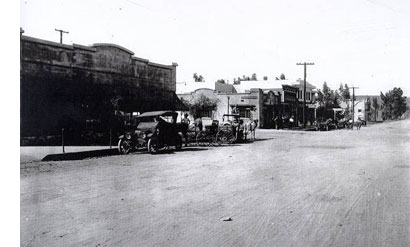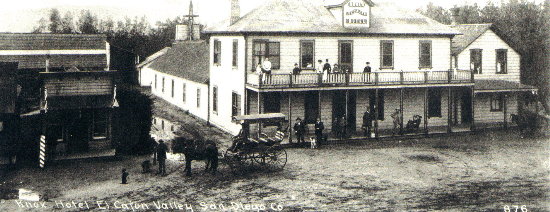
The Knox House Museum
"A Gem of El Cajon"
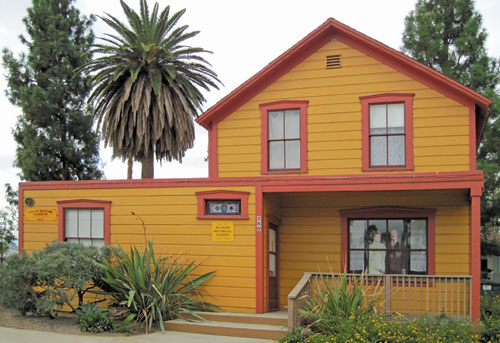
Admission is free. Memberships and donations welcomed
(NO Public Restroom in Museum)
|
|
 Visit our Facebook Page Visit our Facebook Page  |
|
|
|
|
We're Open!
As of January 2023, the Museum is normally open the first and third Saturdays of the month*, |
EVENTS: |
Next Quarterly Member's Meeting:Thursday, October 23rd/, 2025 at 12:00
|
|
Customary ECHS events are published in the Heritage*.
(*the members' quarterly newsletter - Join ECHS and help us preserve history!) |
Why is the Museum those odd colors? |
|
With independence from Spain, the Spanish Dons began to cast envious eyes on the vast holdings of the Roman Catholic Missions. With secularization, California Governor Pio Pico in 1845 confiscated the lands of Mission San Diego de Alcala and granted the eleven square leagues (about 47,000 acres) of El Cajon Valley to Dona Maria Antonio Estudillo, wife of Don Miguel de Pedrorena, to repay a $500 government obligation. The grant included generally the present communities of Lakeside, Santee, Bostonia, Glenview, Johnstown, El Cajon, and part of Grossmont. Following the end of the Civil War - and twenty years before railroads came to this region - people from around the world began arriving overland by wagon or by ship. After sailing from ports on America's east and southern coasts, voyagers sailed south along South America's eastern coast. Fighting the waves around the tip of Argentina and Cape Horn, they sailed up the South American, then Mexico's western coast and into San Diego's fair harbor. From there, they rented or purchased wagons to carry their goods here. The KNOX HOUSE MUSEUM is the first commercial building in El Cajon, erected eleven years after the end of the Civil War. It is the original portion of the hotel that Amaziah Lord Knox built in 1876 near what is now the southwest corner of Main Street and Magnolia Avenue. Originally a two-story, seven-room structure serving as Knox’s residence and hotel, it soon boasted an add-on kitchen and dining room.
Amaziah Lord Knox - Founder of Knox's Corners - later El Cajon 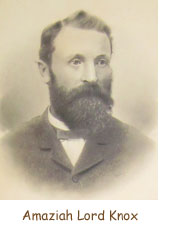 Knox had come to the Valley in 1869, the year that most of the area was formally opened for settlement. Employed by Isaac Lankershim, owner of the greater part of the Rancho El Cajon land grant previously in the possession of the Pedrorena family of Old Town, Knox was hired to manage the planting of wheat and to build a ranch house. Knox had come to the Valley in 1869, the year that most of the area was formally opened for settlement. Employed by Isaac Lankershim, owner of the greater part of the Rancho El Cajon land grant previously in the possession of the Pedrorena family of Old Town, Knox was hired to manage the planting of wheat and to build a ranch house. In 1870, when Knox had been here a year, gold was discovered in Julian. Lying half-way between that town and the growing city of San Diego, Knox--for $1,000 in gold coin--purchased ten acres that was an ideal spot for teamsters, miners, and drovers to overnight. With the number of travelers booming in 1876, Knox built his hotel and some corrals. So successful was the hotel that the bend in the road became known as Knox’s Corners. Two years later there were 25 families living in the valley and a portion of the hotel lobby became the valley post office with Knox as the first postmaster.
|
Copyright 2025 El Cajon Historical Society - All Rights Reserved

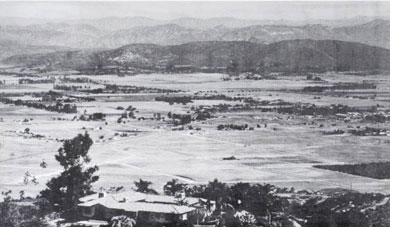 In the early part of the nineteenth century the explorations of the mission padres for pasture land led them to El Cajon Valley (The Box). The surrounding foothills were a barrier to straying cattle as well as a watershed to gather the sparse rainfall for verdant grasslands along the valley floor. For years the pasture lands supported the cattle herds of the mission and its native Indian converts.
In the early part of the nineteenth century the explorations of the mission padres for pasture land led them to El Cajon Valley (The Box). The surrounding foothills were a barrier to straying cattle as well as a watershed to gather the sparse rainfall for verdant grasslands along the valley floor. For years the pasture lands supported the cattle herds of the mission and its native Indian converts. 